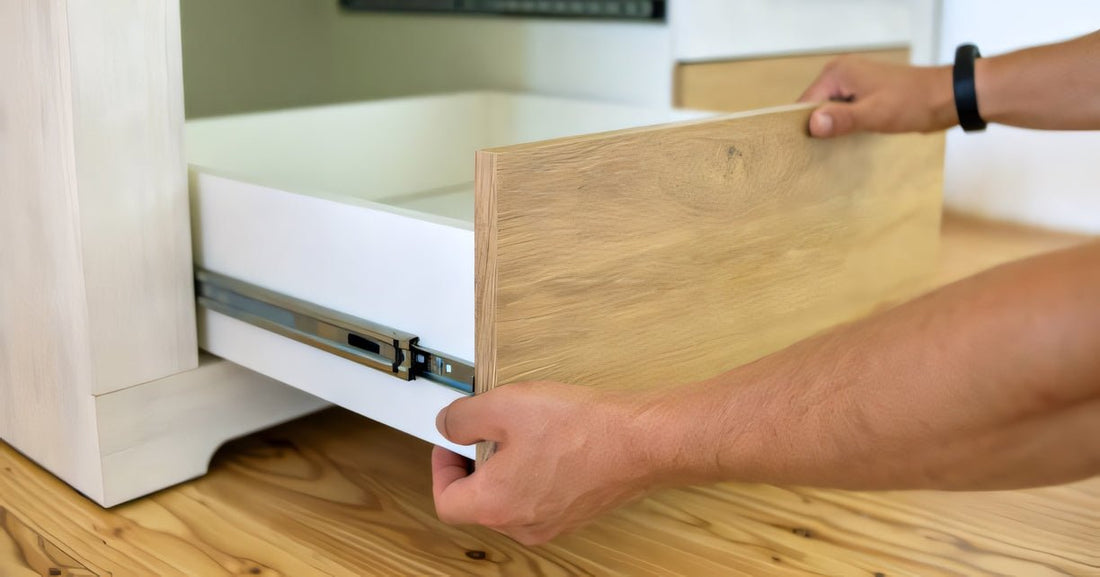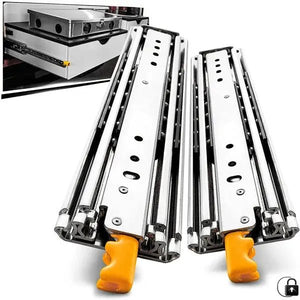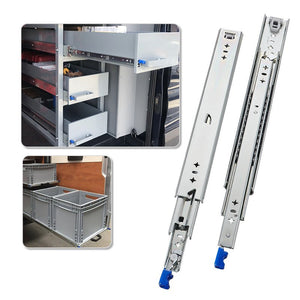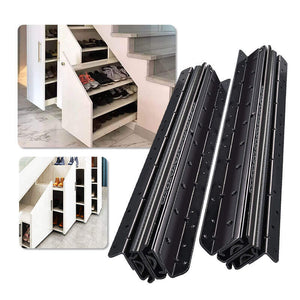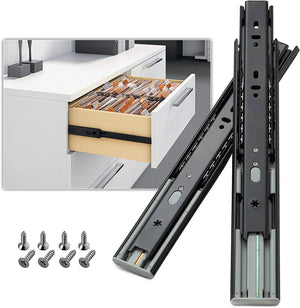I. Introduction
In the realm of furniture functionality, drawer slides play a key role in ensuring smooth drawer operation. Among the many options available, push-open drawer slides are popular for their modern and aesthetically pleasing design. In the following content, we introduce a series of knowledge on how to maintain, replace and maintain push-open drawer slides.
While push-open drawer slides provide a seamless experience, users may encounter challenges that hinder their optimal functionality. This section will shed light on common pain points faced by users, from misalignment issues to wear and tear issues. By addressing these pain points head-on, users can better understand potential roadblocks and equip themselves with the knowledge they need to troubleshoot effectively.

II. Signs of Wear and Tear
Unveiling the Telltale Signs
As with any mechanical component, push-open drawer runners are not immune to the effects of wear and tear. Recognizing the signs of aging is crucial for users aiming to maintain the optimal performance of their furniture. This section will serve as a guide, unveiling the telltale signs that indicate your push-open drawer runners might be in need of attention.
Gradual Decline in Smooth Operation
One of the initial indicators of wear and tear is a gradual decline in the smooth operation of push-open drawer runners. Users may notice a subtle resistance or a less responsive push-open mechanism. Understanding that this decline is a natural consequence of usage will empower users to take proactive measures to address the issue.
Increased Noise Levels
As push-open drawer runners age, an increase in noise levels during operation may become noticeable. The once silent and effortless operation may be accompanied by creaks or squeaks. Exploring the causes behind the heightened noise levels will guide users in identifying specific areas that may require lubrication or adjustments.
Misalignment Issues
Wear and tear can contribute to misalignment issues, disrupting the precise movement of push-open drawer runners. Users may observe slight tilting or uneven extension, impacting both the aesthetics and functionality of the furniture. This section will provide insights into the root causes of misalignment and offer practical solutions for realignment.
Reduced Load-Bearing Capacity
Over time, the load-bearing capacity of push-open drawer runners may experience a decline. This can manifest as a drawer that no longer supports heavy loads as effectively as it once did. Understanding the limitations and load-bearing capacity of the runners will guide users in making informed decisions regarding the weight they place on their drawers.
Visual Indicators of Wear
Beyond functional aspects, there are visual indicators of wear and tear that users can observe. Scratches, rust, or visible signs of friction on the exterior components are cues that the push-open drawer runners may be undergoing wear. This section will guide users in conducting a visual inspection and offer suggestions for addressing cosmetic wear.

III. Required Tools and Materials
When it comes to repairing push-open drawer slides, it's crucial to be equipped with the right tools and materials. Here is a comprehensive checklist to ensure a smooth and effective repair process:
1. Screwdriver set:
- Purpose: Drawer slide rails are generally fixed with screws. When disassembling the drawer assembly, unscrew the screws to help the slide rails be disassembled smoothly.
- Tip: Make sure you have both a flat-blade screwdriver and a Phillips-blade screwdriver for added variety.
2. Wood glue:
- Purpose: If your drawers are made of wood, you can repair any cracks or breaks in the wooden parts of the drawer if the drawer is old and cracks in some places.
- Tip: Use high-quality wood glue and follow recommended drying times to prevent further breakage of the drawers.
3. Replace the slide rail:
- Purpose: This is essential if the existing rails are damaged beyond repair.
- Tip: Measure the dimensions of your drawer and buy slides that fit the specifications.
4. Safety equipment:
- Purpose: For example, gloves, to prevent injuries during replacement and to protect yourself during the repair process.
- Tip: Wear safety gloves and goggles to prevent injury.
5. Spare screws:
- Purpose: To prevent any screws from being lost or damaged during disassembly.
- Tips: Prepare spare screws of various sizes to suit the needs of different parts of the drawer.
6. Instructions:
- Purpose: Provide guidance if the drawer has a specific mechanism or requires unique steps.
- Tip: Refer to the manufacturer's instructions for the most accurate repair steps.
Use these tools and materials to make sure you're ready to fix any issues with push-open drawer slides. Now, let’s dive into the step-by-step guide to fix them effectively.

IV. Step-by-Step Repair Guide
Now that you have gathered the necessary tools and materials, it's time to dive into the step-by-step process of repairing your push-open drawer runners. Follow these detailed instructions to ensure a successful and long-lasting repair:
Disassembly of the Drawer:
Before you start the repair, remove the drawer from its housing. Use your screwdriver set to carefully unscrew any screws holding the drawer together. Pay attention to the order and placement of components as you disassemble to simplify reassembly later.
Examine each component for damage. Identify any cracked wood, bent metal, or malfunctioning mechanisms. Take note of the specific issues you need to address during the repair. This assessment will guide your subsequent steps.
Repairing Wooden Components:
If you've identified cracks or breaks in the wooden parts, apply wood glue to the damaged areas. Press the pieces together firmly and wipe away any excess glue. Allow sufficient time for the glue to dry completely, following the manufacturer's recommendations.
For irreparable runners, carefully remove them and replace them with new ones. Ensure the replacement runners match the dimensions of the original ones. Use your screwdriver to secure the new runners in place, following the pattern observed during disassembly.
Adjusting and Aligning Components:
Once the new runners are in place, adjust and align all components. This step is crucial to ensure smooth functionality. Use pliers or a rubber mallet if necessary, ensuring that all parts fit seamlessly together.
With the repaired or replaced components in optimal condition, begin reassembling the drawer. Secure all screws tightly but be cautious not to overtighten, which may cause damage. Double-check the alignment and movement of the drawer to confirm a successful repair.
Testing and Fine-Tuning:
Before returning the drawer to regular use, perform a series of tests. Open and close the drawer multiple times to check for smooth movement. Make any additional adjustments or fine-tuning as needed to guarantee optimal performance.
Conduct a final inspection to ensure all components are in their proper places and the repair is successful. Clean the drawer and its components using mild cleaning solutions and a soft cloth. This step adds a finishing touch to your repair.
By following this step-by-step guide, you'll effectively repair your push-open drawer runners, extending their lifespan and maintaining optimal functionality.

V. Troubleshooting Common Problems
Push open drawer runners, known for their convenience, may encounter issues affecting their smooth operation. Here's a guide to troubleshooting common problems associated with push open drawer runners.
1 Lack of Smooth Opening
Problem: The drawer may not open smoothly as expected when using the push-open feature.
Solution:
- Check for Obstructions: Ensure there are no items blocking the drawer's path.
- Clean and Lubricate: Remove dust or debris from the runner mechanism and apply lubrication for smoother operation.
- Inspect Mechanism: Examine the push-open mechanism for any visible damage or misalignment.
2 Difficulty in Closing
Problem: The push-open drawer faces challenges in closing seamlessly.
Solution:
- Inspect Closing Mechanism: Check for any hindrance or damage in the closing mechanism.
- Adjust Drawer Alignment: Ensure the drawer is properly aligned within the cabinet, allowing for a smooth closing motion.
- Examine Springs: If applicable, inspect the springs associated with the push-open system for wear or damage.
3 Uneven Opening Force
Problem: The force required for the push-open feature seems uneven or inconsistent.
Solution:
- Inspect Springs: Examine the springs to ensure they are in good condition and evenly distributing force.
- Adjust Tension: If possible, adjust the tension settings to achieve a more consistent opening force.
- Check for Wear: Look for signs of wear on the push-open mechanism and replace any worn-out components.
By troubleshooting these common problems, users can enhance the functionality of their push open drawer runners, ensuring a reliable and efficient experience.

VI. Conclusion
In conclusion, mastering the art of push-open drawer runners, specifically addressing issues and troubleshooting common problems, enhances the overall experience of utilizing this modern convenience in our homes and offices. As we strive for seamless functionality, it's crucial to understand that occasional maintenance and awareness of potential challenges can significantly contribute to the longevity and performance of soft close drawers.
While DIY troubleshooting is encouraged, some complexities may require professional intervention. Manufacturers often provide customer support, and qualified technicians can efficiently address intricate problems. Seeking professional assistance ensures that issues are diagnosed accurately and resolved effectively, preventing potential long-term damage to the push-open drawer system.

